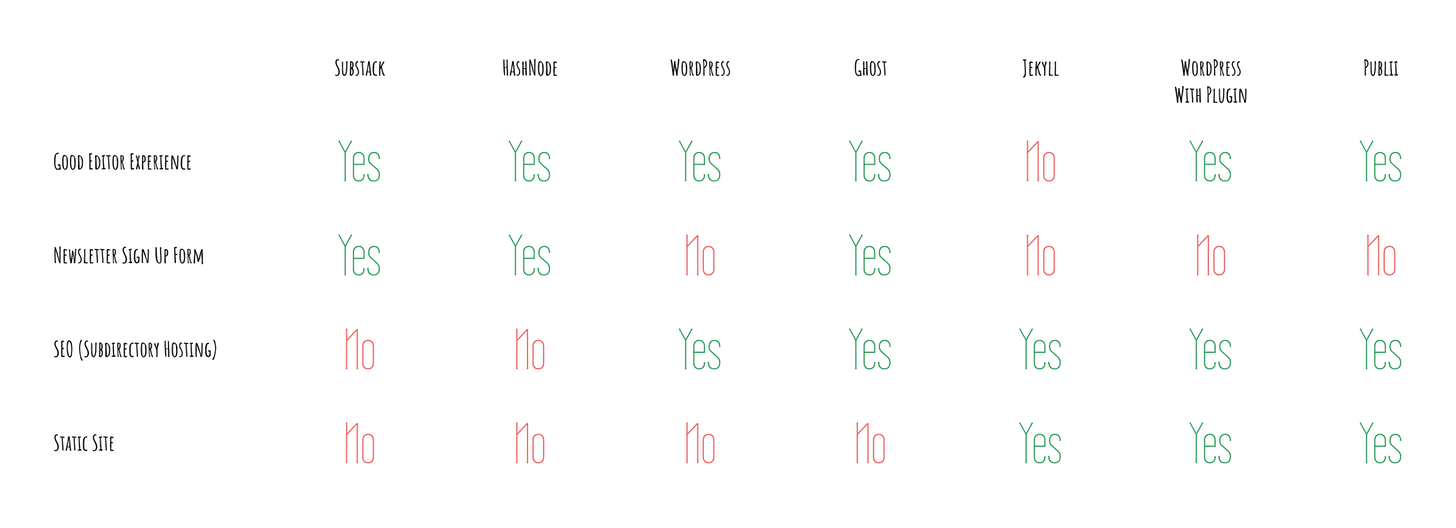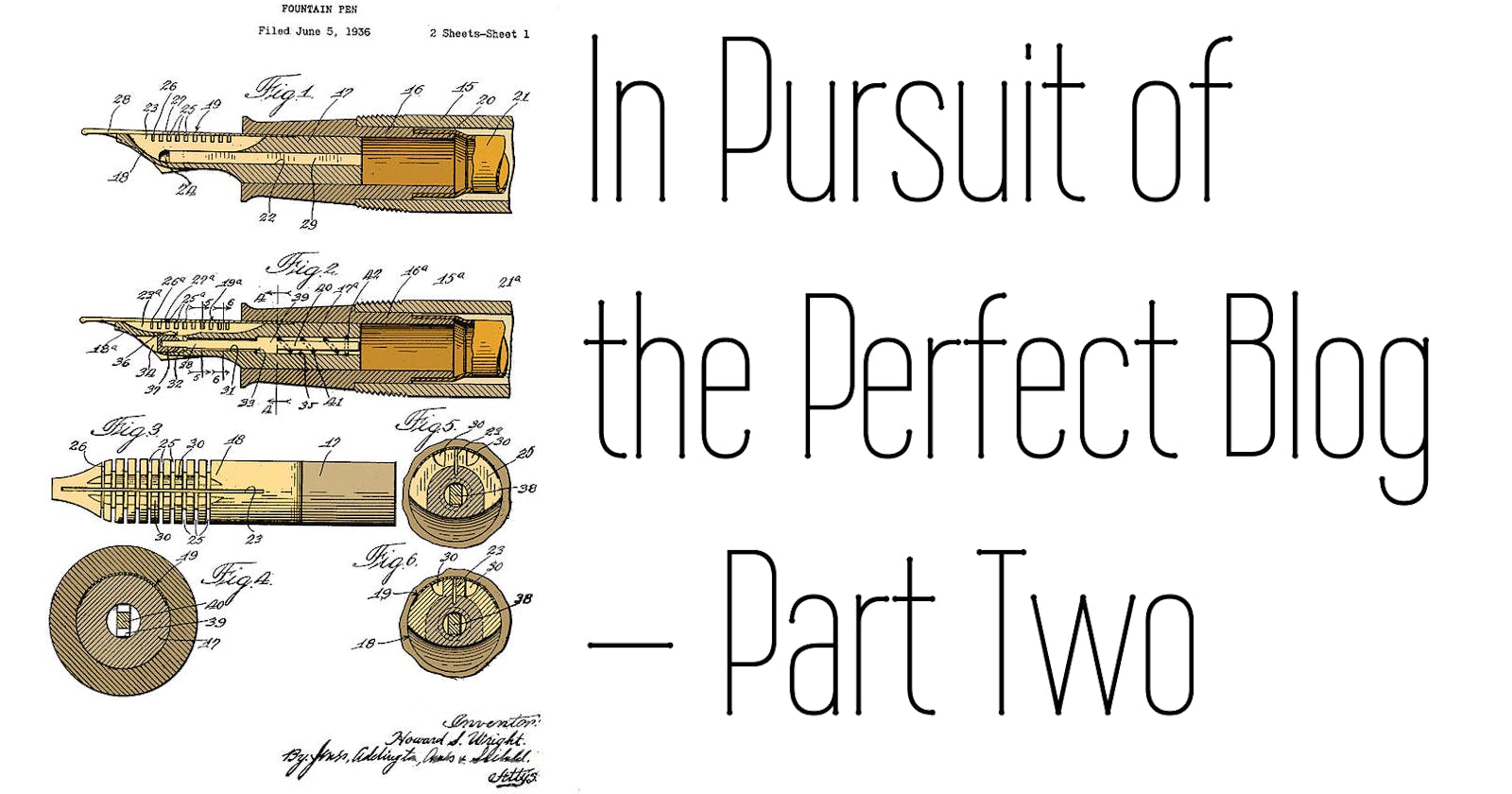Three weeks ago, I wrote In Pursuit of the Perfect Blog, in which I shared my journey to look for a perfect blog for Typogram and Coding Font. One of the hard requirements is to have the blog in a sub-directory URL like www.codingfont.com/blog.
I went through a bunch of options, including Substack, HashNode, WordPress, Ghost, Jekyll, and Publii, and compared them head to head against my requirements, and wrote them down in a chart:

Throughout my journey, I had a lot of interesting findings and realizations that I would like to share with you in a series!
The Coming-back Of Static Site
Coming from a design background, creating HTML/CSS web pages came relatively natural to me, or at least when compared to other programming skills. I spent lots of time trying to break away from my comfort zone of static web pages and learn dynamic programming languages. My first attempt years ago was WordPress; I learned how to set up MySQL databases and write PHP code. Later years, I embraced Vue.js and built dynamic sites with front-end frameworks and API endpoints.
When I was hunting for a blogging platform again years later after my last dance with WordPress, I was surprised to hear the latest public opinion about static sites. I read articles after articles about why people chose to set up a fully static blog and its benefits — it is more secure, faster to load, friendlier for search engines, more cost-effective to host, easier to build and update ... you name it! Static sites are having a full coming back in 2022, if not already.
The static blog is hassle-free to host in any sub-folder. The common denominator of all server environments is a static site server. WordPress, which is built with PHP and MySQL, can be hosted in a sub-folder as well, but only when the server supports PHP and MySQL. My main app is hosted on Firebase, which means a sub-folder from my main app’s server will not accommodate WordPress. The same problem goes with Ghost, another competitive option. A static blog is suitable for any use case and the safest bet.
Own Your Creations
It is natural for creators to want to own their creations. But in this day and age, it is not easy. Publishing your writing on your own website requires technical skills and time commitment. For a casual writer, it is too much to ask to set up and host a blog just to publish one or two occasional articles. With this imbalance of investment and return, it comes Medium and similar blogging services. In the early days, Medium’s uniformed and polished article page design made it feel like everyone was writing for Medium, not on Medium. Many writers complained that their readers mistook them as Medium employees back then. Effectively Medium inexplicitly hired users as writers to enrich their editorial publication, but with no pay. Medium has improved in recent years, giving some ownership back to the writers, but its business model only further confirmed my suspicion of writers being their employees; only now it becomes more official with payment. When Medium subscribers read your articles, Medium shares some of the subscription money with you. In other words, Medium is your boss; readers subscribed to Medium, not to you.
I currently have 900 followers on Medium, but remember that they are followers, not subscribers. I have no access to my followers. I can’t even make sure my publication gets to them. My latest article on Medium has 20 views in total.

Substack is doing much better in this regard. In their business model, if I were to flip on the switch of paid subscription, I would get paid directly from my subscribers, and Substack receives a cut from it. In other words, Writers are the boss, and writers pay Substack for their services, not the other way around. Furthermore, the top left corner of my page is not Substack’s logo that clicks to their home page; instead, it is my publication name that clicks to my publication’s home page. This little design detail says a lot about the critical differences between Medium and Substack.
However, I still don’t own my writing 100% on Substack. For example, I can’t change the site design or modify the HTML to add a canonical link. To back up a little, setting the canonical link of a blog post is to tell the search engine that this page you are indexing is merely a repost; the original post of my article is this other URL; rank them first. Substack doesn’t allow writers to set canonical links, forcing them to publish on Substack first. The canonical link problem of Substack is by design — they want to be the first platform to publish your original content and be ranked higher than your other places by search engines. In other words, they still think they own some part of your content, in other forms that are different than Medium, but nevertheless the same mentality. If they are truly a platform that serves the writers, then they should allow the writers to add whatever links they see fit instead of denying a popular feature request on purpose to benefit themselves.
Back up a hundred years, creators owned their creation by default. Arguably, there were not many middlemen to steal the ownership inexplicitly. Nowadays, it is easier than ever to be a creator but harder to own your creation. These platforms that enable us to be creators are also the ones to take away the ownership of our creation from us. Like many other things, they are a double-edged sword. Let’s be aware.
Coming Next
- Get to your audience
- Separate the authoring experience from the publishing experience
This article is getting longer than I expected! I still have a lot of ideas to share. The next important thing to talk about is how to get to your audience. Providing an easy and direct way to get to your audience is Substack’s most significant innovation and in my opinion, why Substack is getting popular. But let’s not forget we have solved this problem once before — RSS feed. RSS feed democratized the process of growing an audience and getting to them. Not everyone can build a complete web app with user accounts and follow mechanism, nor should they! But relying on popularized social media is a worse solution and what leads us to the scandal over Cambridge Analytica. I see a future when building your site could be as easy as setting up a Facebook or Medium account, while reaching to an audience doesn’t rely on any unwanted middlemen, solely on the users’ will to connect. This then leads to the idea of separating the authoring experience from the publishing experience. If you are curious what I mean by that, stay tuned for Part Three!
❧
See you next week! If you have friends who are interested in founding startups, please consider sharing my newsletter with them!
If you enjoy this series, you can subscribe here:

